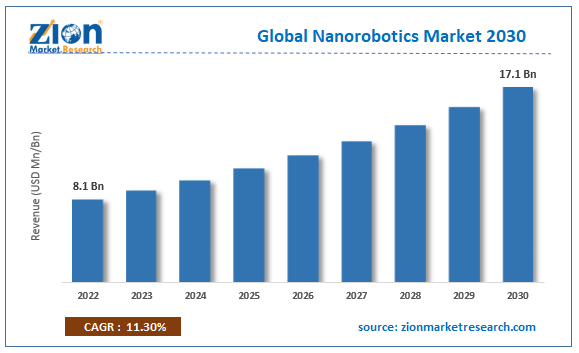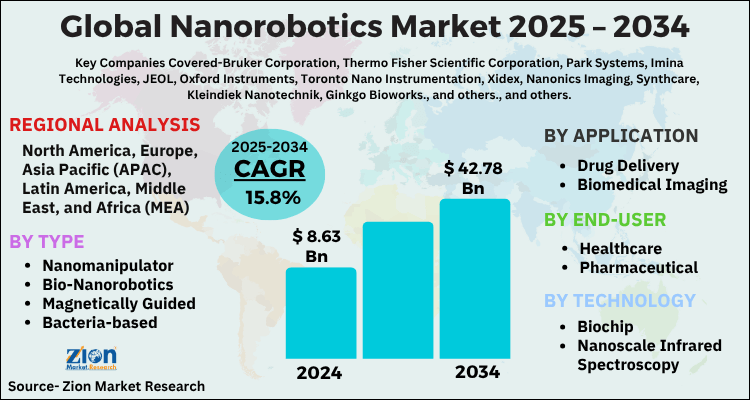Nanorobotics Market Size, Share Report, Analysis, Trends, Growth, 2034

Nanorobotics Market By Type (Nanomanipulator, Bio-Nanorobotics, Magnetically Guided, and Bacteria-based), By Application (Drug Delivery, Biomedical Imaging, Cancer Therapy, Tissue Engineering, and Others), By End-user (Healthcare, Pharmaceutical, Research Institutes, and Military & Defense), By Technology (Biochip, Nanoscale Infrared Spectroscopy, Magnetoelectric Nanoparticles, and Others), and By Region: Global and Regional Industry Overview, Market Intelligence, Comprehensive Analysis, Historical Data, and Forecasts 2025 - 2034
| Market Size in 2024 | Market Forecast in 2034 | CAGR (in %) | Base Year |
|---|---|---|---|
| USD 8.63 Billion | USD 42.78 Billion | 15.8% | 2024 |
Nanorobotics Market: Industry Perspective
The global nanorobotics market size was worth around USD 8.63 billion in 2024 and is predicted to grow to around USD 42.78 billion by 2034 with a compound annual growth rate (CAGR) of roughly 15.8% between 2025 and 2034. The report analyzes the global nanorobotics market's drivers, restraints/challenges, and the effect they have on the demand during the projection period. In addition, the report explores emerging opportunities in the nanorobotics industry.
Nanorobotics Market: Overview
Nanorobotics is an interdisciplinary domain integrating principles of nanotechnology, material science, and robotics for manufacturing robots at the nanoscale. Moreover, the use of nanorobots can result in innovations in medicine, energy production, and manufacturing sectors. Launching of nanorobots can provide impetus to scientific explorations and deeper insights into the understanding of the nanoscale world. It is a cutting-edge domain involving the production and control of tiny robots at the nanoscale level. For the record, nanorobots are also referred to as nanobots and are made from carbon nanotubes, DNA, and proteins.
Key Insights
- As per the analysis shared by our research analyst, the global nanorobotics market is estimated to grow annually at a CAGR of around 15.8% over the forecast period (2025-2034).
- Regarding revenue, the global nanorobotics market size was valued at around USD 8.63 billion in 2024 and is projected to reach USD 42.78 billion by 2034.
- The nanorobotics market is projected to grow at a significant rate due to the Growth in targeted drug delivery, diagnostics, and nanoscale medical applications fuels demand. Advancements in nanotechnology and robotics further support the market.
- Based on Type, the Nanomanipulator segment is expected to lead the global market.
- On the basis of Application, the Drug Delivery segment is growing at a high rate and will continue to dominate the global market.
- Based on the End-user, the Healthcare segment is projected to swipe the largest market share.
- By Technology, the Biochip segment is expected to dominate the global market.
- Based on region, Asia-Pacific is predicted to dominate the global market during the forecast period.
Nanorobotics Market: Growth Factors
Highlight on innovations in nanotechnology and regenerative medicine will drive the global market trends
Supportive government guidelines and a rise in the allocation of funds for developing nanorobots will steer the expansion of the nanorobotics market across the globe. Furthermore, innovations in molecular robots and a growing focus on regenerative medicine and nanotechnology will spearhead the expansion of the market across the globe. The rise in commercial activities witnessed in the healthcare sector will embellish the growth of the market across the globe.
Large-scale use of nanotechnology in industrial automation, medicine, precision farming activities, pharmaceuticals, and environmental remediation will steer the expansion of the market globally. Apart from this, an increase in the use of nanotechnology in various chronic disorders, such as diabetes, will prompt the expansion of the global market size in the years ahead. New product launches are likely to make notable contributions to the growth of the global market in the upcoming years. For instance, in 2019, DNA robots were manufactured by researchers. Reportedly, these products encompassed a track & walker system for reaching the target site.
Nanorobotics Market: Restraints
High production costs of nanorobots can put the brakes on the global industry expansion over 2023-2030
The rise in the cost of production of nanorobots makes it difficult for small-scale firms and healthcare institutes to purchase them. This can reduce its sales and restrict the growth of the global nanorobotics industry. Apart from this, improper laws governing the use of nanorobots in the healthcare sector will further impede global industry expansion.
Nanorobotics Market: Opportunities
A surge in the cases of chronic disorders will open new growth avenues for the global market by 2030
The rise in the occurrence of chronic diseases and the need for proficient drug formulation will create new growth opportunities for the global nanorobotics market in the years ahead. An increase in the research activities for finding new modes of diagnosing cancer at its initial stage to increase the probability of curability is likely to enhance the use of nanorobots in healthcare research. This, in turn, will pave the way for the immense expansion of the market across the globe.
Nanorobotics Market: Challenges
Growing concerns related to maintaining the confidentiality of patient healthcare data can prove to be a huge challenge in the expansion of the industry across the globe
Issues such as copyright violations, patient privacy, and misuse of new medical technology can prove to be a big challenge for the global nanorobotics industry expansion.
Nanorobotics Market: Segmentation Analysis
The global nanorobotics market is segmented based on type, application, end-user, technology, and region.
Based on Type, the global nanorobotics market is divided into nanomanipulator, bio-nanorobotics, magnetically guided, and bacteria-based. The nanomanipulator segment, which accumulated nearly 45% of the global market revenue share in 2024, is predicted to register the highest CAGR in the forecasting years. The growth of the segment in the forecasting timeline can be attributed to the ability of the product in nanopositioning. Apart from this, these products find application in physics and chemistry domains and can handle atoms and molecules effectively.
On the basis of Application, the global nanorobotics market is bifurcated into drug delivery, biomedical imaging, cancer therapy, tissue engineering, and others. The drug delivery segment, which garnered a huge share of the global industry in 2024, is anticipated to lead the global industry over the projected timeframe. The segmental growth over the assessment timeline can be subject to a surge in the demand for nanorobotics in nanomedicine with the commercialization of in vivo imaging, drug delivery, active implants, drug treatment, biomaterials, and in vitro diagnostics in the healthcare sector.
By End-user, the global nanorobotics market is split into healthcare, pharmaceutical, research institutes, and military & defense.
In terms of Technology, the global nanorobotics market is categorized into biochip, nanoscale infrared spectroscopy, magnetoelectric nanoparticles, and others.
Nanorobotics Market: Report Scope
| Report Attributes | Report Details |
|---|---|
| Report Name | Nanorobotics Market |
| Market Size in 2024 | USD 8.63 Billion |
| Market Forecast in 2034 | USD 42.78 Billion |
| Growth Rate | CAGR of 15.8% |
| Number of Pages | 209 |
| Key Companies Covered | Bruker Corporation, Thermo Fisher Scientific Corporation, Park Systems, Imina Technologies, JEOL, Oxford Instruments, Toronto Nano Instrumentation, Xidex, Nanonics Imaging, Synthcare, Kleindiek Nanotechnik, Ginkgo Bioworks, and others. |
| Segments Covered | By Type, By Application, By End-user, By Technology, and By Region |
| Regions Covered | North America, Europe, Asia Pacific (APAC), Latin America, The Middle East and Africa (MEA) |
| Base Year | 2024 |
| Historical Year | 2020 to 2023 |
| Forecast Year | 2025 - 2034 |
| Customization Scope | Avail customized purchase options to meet your exact research needs. Request For Customization |
Nanorobotics Market: Regional Analysis
Asia-Pacific is anticipated to maintain its global market leadership position over the expected timeline
Asia-Pacific, which contributed about 57% of the global nanorobotics market revenue in 2024, will be a leading region over the projected timespan. Furthermore, the regional market growth can be credited to the rise in the highlight of various governments in the region on enhancing oral disease treatment. Moreover, the rise in healthcare spending in countries such as India and China will augment the regional market expansion. Furthermore, robot-assisted dentistry helps in repairing oral lesions through the use of nanorobots. Moreover, the use of nanorobots in dental care will promote the global market demand in the upcoming years.
The European nanorobotics industry is set to register the fastest CAGR in the next couple of years, owing to a rise in the aging population prone to suffering from chronic diseases. Apart from this, an increase in healthcare spending in European countries will spur the growth of the industry on the continent. A rise in private as well as public funding will drive the industry trends in Europe. Moreover, the presence of key players in Europe will further contribute substantially to the expansion of the industry on the continent.
Nanorobotics Market: Competitive Analysis
The report provides a company market share analysis to give a broader overview of the key market players. In addition, the report also covers key strategic developments of the market, including acquisitions & mergers, new product launches, agreements, partnerships, collaborations & joint ventures, research & development, and regional expansion of major participants involved in the nanorobotics market on a global and regional basis.
The global nanorobotics market is dominated by players like:
- Bruker Corporation
- Thermo Fisher Scientific Corporation
- Park Systems
- Imina Technologies
- JEOL
- Oxford Instruments
- Toronto Nano Instrumentation
- Xidex
- Nanonics Imaging
- Synthcare
- Kleindiek Nanotechnik
- Ginkgo Bioworks.
- and others.
The global nanorobotics market is segmented as follows;
By Type
- Nanomanipulator
- Bio-Nanorobotics
- Magnetically Guided
- Bacteria-based
By Application
- Drug Delivery
- Biomedical Imaging
- Cancer Therapy
- Tissue Engineering
- Others
By End-user
- Healthcare
- Pharmaceutical
- Research Institutes
- Military & Defense
By Technology
- Biochip
- Nanoscale Infrared Spectroscopy
- Magnetoelectric Nanoparticles
- Others
By Region
- North America
- The U.S.
- Canada
- Europe
- France
- The UK
- Spain
- Germany
- Italy
- Rest of Europe
- Asia Pacific
- China
- Japan
- India
- South Korea
- Southeast Asia
- Rest of Asia Pacific
- Latin America
- Brazil
- Mexico
- Rest of Latin America
- Middle East & Africa
- GCC
- South Africa
- Rest of Middle East & Africa
Table Of Content
Methodology
FrequentlyAsked Questions
Nanorobotics is an interdisciplinary domain integrating principles of nanotechnology, material science, and robotics for manufacturing robots at the nanoscale.
The global nanorobotics market is expected to grow due to Growth in targeted drug delivery, diagnostics, and nanoscale medical applications fuels demand. Advancements in nanotechnology and robotics further support the market.
According to a study, the global nanorobotics market size was worth around USD 8.63 Billion in 2024 and is expected to reach USD 42.78 Billion by 2034.
The global nanorobotics market is expected to grow at a CAGR of 15.8% during the forecast period.
Asia Pacific is expected to dominate the nanorobotics market over the forecast period.
Leading players in the global nanorobotics market include Bruker Corporation, Thermo Fisher Scientific Corporation, Park Systems, Imina Technologies, JEOL, Oxford Instruments, Toronto Nano Instrumentation, Xidex, Nanonics Imaging, Synthcare, Kleindiek Nanotechnik, Ginkgo Bioworks, among others.
The report explores crucial aspects of the nanorobotics market, including a detailed discussion of existing growth factors and restraints, while also examining future growth opportunities and challenges that impact the market.
HappyClients
Zion Market Research
Tel: +1 (302) 444-0166
USA/Canada Toll Free No.+1 (855) 465-4651
3rd Floor,
Mrunal Paradise, Opp Maharaja Hotel,
Pimple Gurav, Pune 411061,
Maharashtra, India
Phone No +91 7768 006 007, +91 7768 006 008
US OFFICE NO +1 (302) 444-0166
US/CAN TOLL FREE +1 (855) 465-4651
Email: sales@zionmarketresearch.com
We have secured system to process your transaction.
Our support available to help you 24 hours a day, five days a week.
Monday - Friday: 9AM - 6PM
Saturday - Sunday: Closed






